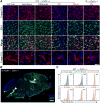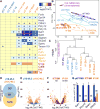A Combination of Ontogeny and CNS Environment Establishes Microglial Identity
- PMID: 29861285
- PMCID: PMC6023731
- DOI: 10.1016/j.neuron.2018.05.014
A Combination of Ontogeny and CNS Environment Establishes Microglial Identity
Abstract
Microglia, the brain's resident macrophages, are dynamic CNS custodians with surprising origins in the extra-embryonic yolk sac. The consequences of their distinct ontogeny are unknown but critical to understanding and treating brain diseases. We created a brain macrophage transplantation system to disentangle how environment and ontogeny specify microglial identity. We find that donor cells extensively engraft in the CNS of microglia-deficient mice, and even after exposure to a cell culture environment, microglia fully regain their identity when returned to the CNS. Though transplanted macrophages from multiple tissues can express microglial genes in the brain, only those of yolk-sac origin fully attain microglial identity. Transplanted macrophages of inappropriate origin, including primary human cells in a humanized host, express disease-associated genes and specific ontogeny markers. Through brain macrophage transplantation, we discover new principles of microglial identity that have broad applications to the study of disease and development of myeloid cell therapies.
Keywords: Csf1r; Tmem119; brain macrophage; glial biology; microglia; neuroimmunity; ontogeny; transplantation.
Copyright © 2018 Elsevier Inc. All rights reserved.
Conflict of interest statement
The authors declare no competing interests
Figures







References
-
- Ajami B, Bennett JL, Krieger C, McNagny KM, Rossi FMV. Infiltrating monocytes trigger EAE progression, but do not contribute to the resident microglia pool. Nat Neurosci. 2011;14:1142–1149. - PubMed
-
- Ajami B, Bennett JL, Krieger C, Tetzlaff W, Rossi FMV. Local self-renewal can sustain CNS microglia maintenance and function throughout adult life. Nat Neurosci. 2007;10:1538–1543. - PubMed
Publication types
MeSH terms
Substances
Grants and funding
- T32 MH019938/MH/NIMH NIH HHS/United States
- P30 NS069375/NS/NINDS NIH HHS/United States
- R01 CA216054/CA/NCI NIH HHS/United States
- R01 DA015043/DA/NIDA NIH HHS/United States
- K08 NS085324/NS/NINDS NIH HHS/United States
- L30 MH108106/MH/NIMH NIH HHS/United States
- R37 DA015043/DA/NIDA NIH HHS/United States
- P50 AG047366/AG/NIA NIH HHS/United States
- K08 NS091527/NS/NINDS NIH HHS/United States
- S10 RR025518/RR/NCRR NIH HHS/United States
- K08 MH112120/MH/NIMH NIH HHS/United States
- K08 NS075144/NS/NINDS NIH HHS/United States
- F31 NS078813/NS/NINDS NIH HHS/United States
LinkOut - more resources
Full Text Sources
Other Literature Sources
Medical
Molecular Biology Databases
Miscellaneous

